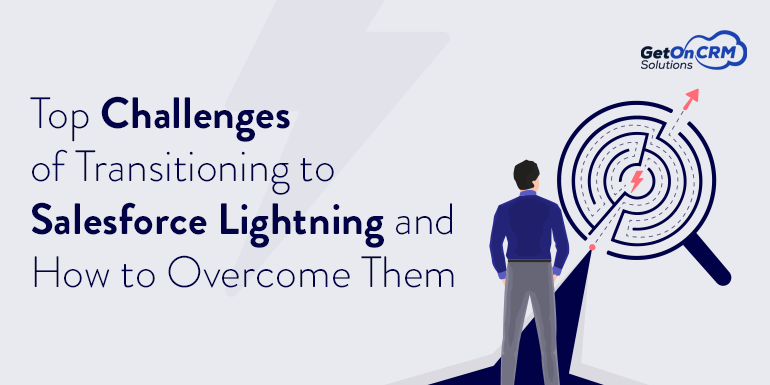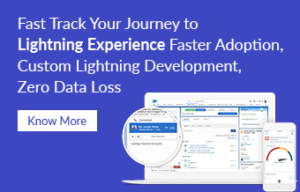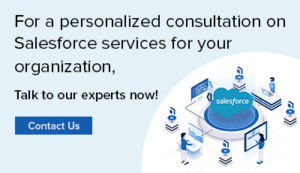
Top Challenges of Transitioning to Salesforce Lightning and How to Overcome Them
- August 20, 2020
- 15 minutes
- 2053
In the present scenario, the demand for the Salesforce Lightning is increasing. Owing to the numerous benefits that it provides, businesses are migrating from Salesforce Classic to Salesforce Lightning. Moreover, the exceptional functions, features, and constant rollouts are other reasons for the increasing adoption.
However, moving to Salesforce Lightning development is not that easy; it comes with a number of challenges. Even though there are challenges, following the right mitigating approaches can help in dealing with the challenges better. Here are some of the top challenges that you may face during the migration to Salesforce Lightning and the effective ways to deal with them.
1. Wrong Timing
One of the major challenges that businesses face while adopting the Salesforce Lightning is the wrong timing. Even though Lightning is an enhanced Salesforce CRM, rushing to adopt it is not the right approach. Without deciding the correct time for the transition, the businesses are likely to experience delays in their ongoing projects. This can affect the relationship with their customers and impact the business reputation.
Mitigating Approach
In order to overcome this challenge, the optimum solution is to be conscious of the timing of migration. Businesses need to check the various projects that are in process. In case your team is in the middle of a major project, going for the migration can affect the project significantly. Hence, delaying the migration until the project ends would be an ideal decision. Make sure to choose such timing when your business will experience very little impact and ensure the success of all your projects. Considering the duration of migration is also important.
1. Wrong Timing
One of the major challenges that businesses face while adopting the Salesforce Lightning is the wrong timing. Even though Lightning is an enhanced Salesforce CRM, rushing to adopt it is not the right approach. Without deciding the correct time for the transition, the businesses are likely to experience delays in their ongoing projects. This can affect the relationship with their customers and impact the business reputation.
Mitigating Approach
In order to overcome this challenge, the optimum solution is to be conscious of the timing of migration. Businesses need to check the various projects that are in process. In case your team is in the middle of a major project, going for the migration can affect the project significantly. Hence, delaying the migration until the project ends would be an ideal decision. Make sure to choose such timing when your business will experience very little impact and ensure the success of all your projects. Considering the duration of migration is also important.
2. Greater Customizations in Salesforce Classic
Salesforce comes with great flexibility options in order to meet the unique needs of different businesses. Most businesses have highly customized versions of Salesforce Classic in order to make the most of the available features. Starting from custom objects to the custom homepage components, there can be a lot of customizations. The high range of customizations can lead to certain complications during the migration process. It can result in challenges like performance issues, feature redundancy, and more.
Mitigating Approach
Conducting an analysis and understanding the Salesforce Classic customizations prior to the migration is an optimum solution to avoid complications. Businesses have to list down all the customizations they have in Salesforce classic. Then, you would have to check whether you require all the customizations in Salesforce Lightning or not.
By prioritizing the custom components, you can easily take action to optimize performance and usage. A detailed analysis can help in reducing the potential issues and enhancing the efficiency of Salesforce Lightning.
3. Lack of Strategy
The absence of a well-designed strategy is another significant challenge faced by businesses during the transition to Salesforce Lightning. This can affect your projects, team members, Salesforce functionality, as well as a result in more time for the migration.
Mitigating Approach
Preparing an appropriate roll-out strategy is the right way to deal with this challenge. Rolling out in phase can prove to be even more successful. Document all the elements that will be affected by the transition and accordingly prepare strategies. Make sure to identify the personas or different groups in the organization who will be affected. Then, consider rolling out the initial changes to the group in order to ensure a smooth transition.
4. Overloading of Functions
The feature-rich Salesforce Lightning platform offers a wide range of customizable features to the businesses. But it is important to decide whether all the features of Lightning are required and relevant to meet the needs of your business or not.
However, with the wide assortment of options, it often becomes difficult for the business to decide which all features are actually needed. In such situations, businesses may choose many features, thereby resulting in overloading of functions. This not only reduces the efficiency of Salesforce Lightning but also impacts the user experience significantly.
Mitigating Approach
To overcome this challenge, a potential solution is to go through all the customizations and make a careful selection. Businesses need to keep their core objectives, goals, and user experience in mind while making a choice. It is important to choose the customizations that are highly essential for enhancing the processes and ensuring the smooth running of your organization.
Moreover, interacting with your internal team, including the sales, customer service, and marketing professionals can help in clearly identifying the features of Salesforce Lightning that are relevant and essential. This enables you to keep Salesforce light and ensure faster performance.
4. Overloading of Functions
The feature-rich Salesforce Lightning platform offers a wide range of customizable features to the businesses. But it is important to decide whether all the features of Lightning are required and relevant to meet the needs of your business or not.
However, with the wide assortment of options, it often becomes difficult for the business to decide which all features are actually needed. In such situations, businesses may choose many features, thereby resulting in overloading of functions. This not only reduces the efficiency of Salesforce Lightning but also impacts the user experience significantly.
Mitigating Approach
To overcome this challenge, a potential solution is to go through all the customizations and make a careful selection. Businesses need to keep their core objectives, goals, and user experience in mind while making a choice. It is important to choose the customizations that are highly essential for enhancing the processes and ensuring the smooth running of your organization.
Moreover, interacting with your internal team, including the sales, customer service, and marketing professionals can help in clearly identifying the features of Salesforce Lightning that are relevant and essential. This enables you to keep Salesforce light and ensure faster performance.
5. Decline in Performance Health
The main reason for adopting Salesforce Lightning is the increase in the productivity of businesses. However, post the migration of Salesforce Lightning, your business might experience certain issues with the performance. The performance issues may include high loading time, less responsive pages, complications in navigations, scalability issues, and more. These performance issues usually result due to a lack of proper analysis before the migration. This ultimately leads to a decrease in the productivity of the business as well as a significant impact on the user experience.
Mitigating Approach
Conducting a health assessment of the Salesforce is an optimum solution to overcome this challenge. The health assessment helps in identifying the potential performance issues before the transition to Lightning. It enables you to find out the obstructions or roadblocks that pose a problem for the smooth workflow.
An ideal assessment must include organization tools to provide reports about the Salesforce health, code analysis tool for the analysis of the efficiency of the custom codes, and data quality dashboards. With a thorough assessment, identifying the potential bottlenecks that might create performance issues becomes easy. This, in turn, enables the businesses to find alternative strategies in order to restructure the custom components. Also, analyzing the data quality and improving it prior to migration proves to be beneficial.
6. Buy-In Through the Business End-Users
Undergoing a transition from Salesforce Classic to Salesforce Lightning seems to be a big change for every business. In such a situation, it seems right on the part of your team members to think about productivity as well as learning curve issues that may arise due to the change. The major change may even pose difficulty for the users to find the daily used and minor features. They may even face difficulty and feel uncomfortable in completing the simple tasks.
Mitigating Approach
In order to handle this situation effectively, it is important to use the Design-Thinking as well as the persona approach. It will enable your business to easily identify the people who will mainly be impacted by the change. This gives you an opportunity to bring in the essential resources in order to manage the migration effectively. Conducting interactive sessions and explaining in detail about the features as well as workflows of the new process can also help the users to gain a better understanding. Training the admin also can prove to be more beneficial for the business.
7. Lack of Team Readiness
Lack of the readiness of the team members is yet another challenge that the businesses face during the migration to Salesforce Lightning. This can result in team members being unable to work with the new process. As a result of this, the daily operation of your business may get affected, and the team members may start to fall back.
Mitigating Approach
In order to mitigate this challenge, businesses require conducting a readiness check prior to the adoption of the new Salesforce CRM platform. This can help in making the team members familiar with the process. Moreover, providing them with training through the training sessions about the various functions that they will be using on the new platform can be helpful.
7. Lack of Team Readiness
Lack of the readiness of the team members is yet another challenge that the businesses face during the migration to Salesforce Lightning. This can result in team members being unable to work with the new process. As a result of this, the daily operation of your business may get affected, and the team members may start to fall back.
Mitigating Approach
In order to mitigate this challenge, businesses require conducting a readiness check prior to the adoption of the new Salesforce CRM platform. This can help in making the team members familiar with the process. Moreover, providing them with training through the training sessions about the various functions that they will be using on the new platform can be helpful.
8. Delay in Implementation
The challenge of Salesforce Lightning does not end even after migration. After complete migration, implementing the new CRM, and starting to use it is another challenge for the new users. As Salesforce Lightning offers a wide range of features, its implementation can take a long time.
Mitigating Approach
However, there is a solution to handle this challenge too. Opting for a phase-wise rollout is an ideal approach to overcome this challenge effectively. For this, prioritizing the features and rolling it out for selected users at first is important. Later, it can be rolled out for the larger audience. Collaborating with the partners having in-depth knowledge in this area can prove to be profitable for your business.
Winding Up
Apart from the challenges of Salesforce Lightning migration that are mentioned above, there are few other challenges too. One of them is future updates and scalability issues. However, with the appropriate mitigation approaches, it is possible to overcome the potential challenges easily. Moreover, as the platform offers ample benefits to the organizations, a few challenges must not discourage businesses from adopting it.
With proper planning and execution, availing the benefits of the platforms becomes very easy. Start with deciding on the right time to migrate, followed by effective strategy framing, and finally, optimum management of the entire process. With Salesforce Lightning, your organization is sure to experience optimum enhancement in productivity and user experiences.
If you are thinking about migrating your business from Salesforce classic to Salesforce lightning then Contact us. At GetOnCRM Solutions, Our team of highly experienced Salesforce Lightning Experts can help you to customize and build beautiful apps and future for your platform on your unique business needs.









